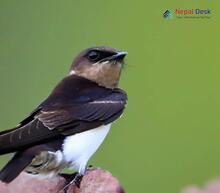Delichon: Exploring the Bird Species in Nepal, Their Classification, Common Features, Evolutionary Relationships, and Nomenclature
Nestled in the majestic Himalayan mountain range, Nepal is home to various bird species that attract birdwatchers from around the globe. Among these fascinating creatures is the Delichon – a genus of small birds commonly known as house martins. Here, we delve into the Delichon's classification, their common features, evolutionary relationships, and nomenclature.
Classification and Nomenclature
Delichon is a genus belonging to the swallow family (Hirundinidae). These birds are typically characterized by their agile flight patterns and distinctive forked tails. The Delichon genus comprises three species:
1. Asian house martin (Delichon dasypus) - found across Asia and northeastern China.
2. Common house martin (Delichon urbicum) - spread throughout Europe, Africa, and Asia Minor.
3. Nepal house martin (Delichon nipalense) - endemic to the mountainous regions of Nepal.
These bird species are often subdivided into different populations based on geographical location and notable differences in appearance or behavior, known as subspecies.
Common Features
House martins are small birds with short wings and a stout body structure that allows for agile aerial maneuvers. They have black or blue feathered upperparts with a glossy sheen and contrasting white underparts. One of their distinctive features is a broad white rump patch that separates their back from their tail.
Typically insectivorous, Delichon feed on flying insects while in flight. These birds are also known for constructing mud nests on vertical surfaces such as walls or cliffs, where they lay their eggs and raise their young.
Evolutionary Relationships
As members of the Hirundinidae family, Delichon share an evolutionary lineage with other swallows and martins. Genetic studies suggest that their closest relatives are swifts from the Apodidae family. Interestingly, these two families split around 34 to 50 million years ago, leading to different evolutionary paths.
It is believed that the Delichon genus originated from southeastern Asia before expanding its range into Europe and Africa. Fossil records of Delichon species have been found in continental Europe and Great Britain, dating as far back as half a million years.
Conservation and Importance
House martins play an essential role in controlling insect populations, particularly mosquitoes, flies, and ants. This is especially crucial in Nepal, where malaria is a significant public health concern. Additionally, they contribute to maintaining overall ecological balance within their habitats.
However, like many other bird species worldwide, house martins face threats such as habitat loss, climate change, and pesticide exposure. It is crucial to raise awareness about these avian jewels' unique characteristics and the need for conservation efforts to protect their continued existence.
In conclusion, the Delichon genus comprises fascinating bird species that captivate birdwatchers and nature enthusiasts alike. Understanding their classification, common features, evolutionary relationships, and nomenclature enables us to appreciate these small marvels even more and highlights the importance of their conservation in a country like Nepal with its rich biodiversity.




